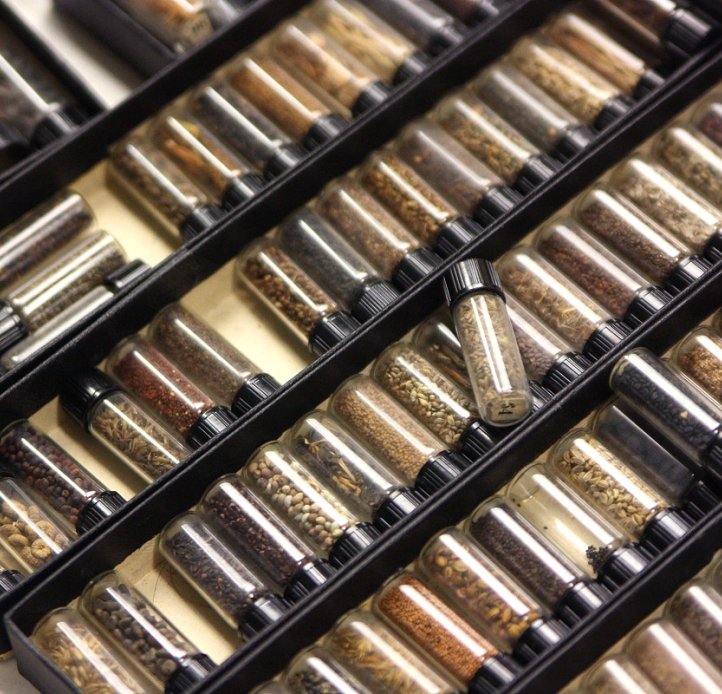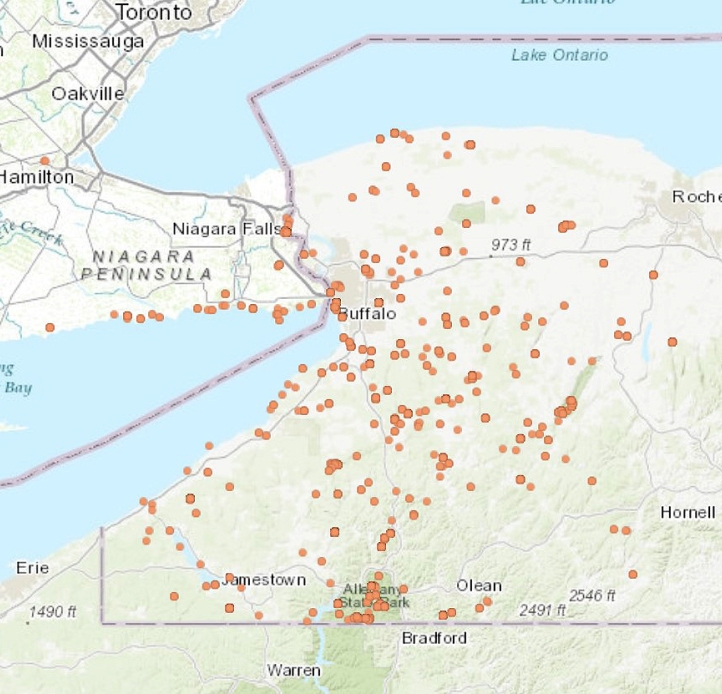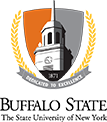
Exploring the Flora of Western New York
The Eckert Herbarium is named for the late Dr. Theodore Eckert, a distinguished teaching professor. He was the herbarium's first curator, and his specimens formed the basis of the original collection. The collection features the vascular and mycological flora of Western New York. The majority of the specimens date from the '60s, '70s and '80s; the earliest date from 1861 through the turn of the 20th century.

Visit Us
The Eckert Herbarium is located in the Science and Mathematics Complex (SAMC) 245.
Thursdays 9:00 a.m. to noon during the academic year or by appointment.
Contact (716) 878-4609 (Thursday hours only) or Dr. Daniel Potts at (716) 878-5203.
Our Collections

Fungi
The Dr. James D. Haynes Mycological Collection includes approximately 1,600 specimens from New York State.

Vascular Plants
The collection of vascular plants includes about 16,250 specimens, primarily from the eight counties of western New York; there are also many collections from elsewhere in New York and North America.

Lichens
Our database provides access to a privately held collection of lichens from Western New York (WNY) and Downeast Maine, as well as records of lichens from WNY deposited at other herbaria.

Lichens Map
The map includes data on specimens held at a local privately held collection and at herbaria across the United States. Users can download label data for these specimens.
Herbarium Database
The Herbarium Database, an application for Microsoft Access, is used to create a simple, searchable database of herbarium specimens. In addition, the application allows the user the printing of specimen labels from records in the database. Its creators believe that the Herbarium Database may be most appropriately used in personal and small institutional herbaria.
Flowering Plants of Western New York
Our portfolio of wildflowers, flowering shrubs and vines growing without cultivation in Western New York state includes several images of a species including habitat views, general views, and detailed views of the inflorescence, flowers, and fruits.
This non-technical resource is intended for use by educators, students, and naturalists. The portfolio employs the two popular field guides to the flora of the Northeastern United States; Wildflowers of Northeastern/North Central North America (Roger Tory Peterson, 1968) and the Newcomb's Wildflower Guide (Lawrence Newcomb, 1977).
How to Use the Portfolio
The photographs are arranged alphabetically by their technical name. To find a plant, first look up its technical name in either the Petersen or Newcomb field guides.
For example, to find the wildflower, Carolina spring beauty, go to page 32 in Peterson; its technical name is Claytonia caroliniana. Below these directions are links to several galleries of photographs. Each gallery has two guide words analogous to those at the top of a page in a dictionary. Select a gallery based on the generic (first) name of you want; in this example, Claytonia. Open the gallery and advance through the photographs until you arrive at Claytonia caroliniana.
There are buttons for getting more information about a photograph, for downloading individual images or the entire portfolio, starting a slide show, and sharing the image.
Downloading Images
The photographs are copyright-free, and are without charge. Please credit Lincoln Nutting, the Eckert Herbarium, and Buffalo State College.
Additional Non-technical Resources
Who is Lincoln Nutting?
Scientist, Photographer, and Naturalist
Born in Wellesley, MA, and educated at Worcester Polytechnic Institute, Lincoln Nutting, Linc to his friends, came to Western New York in 1941 to work in the chemical industry in Niagara Falls. In his spare time, he pursued his interests in nature and photography, earning respect and praise for his photographs of insects. In the late 1970s and early 1980s, Mr. Nutting assembled the portfolio of Kodachrome slides of common local wildflowers and shrubs presented here. Linc maintained active memberships in the Buffalo Audubon Society, the Buffalo Ornithological Society, and the Niagara Frontier Botanical Society and was a long time supporter of the Central/Western New York chapter of the Nature Conservancy. Mr. Nutting died in 2014.
ECK Happenings
The Eckert Herbarium enjoyed a full year of accessibility after a long COVID closure.
Statistics
- ECK acquired about 128 specimens: VASCULAR PLANTS: E. Danielson (110 WNY), J. Battaglia (11 WNY, NY), J. Titus (6 WNY); FUNGI: 0.
Actions
- The herbarium responded to requests for assistance or information from the following persons or organizations: a student at SUNY-ESF, the NY State Natural Heritage Program, a former faculty member, and, on two occasions, WNY PRISM.
- Two graduate students (Biology and Art Conservation) used the vascular plant collections in projects for their degree programs.
- Work continued on the new herbarium’s facilities, supplies, and organization.
- Jim Battaglia published three articles on two 19th century collectors of local plants and lichens in Clintonia, Volume 37, Issue 2, May 2022.
Statistics
The herbarium closed in December 2020 due to the novel coronavirus. Some activities continued despite the closure. ECK will reopen in August 2021.
- ECK acquired about 79 specimens from WNY and NY; this number includes a gift from Diane Evans of Tonawanda, NY. VASCULAR PLANTS: D. Evans (49 WNY), J. Battaglia (29 WNY, NY), J. Schlegel (1): FUNGI: 0
- Dawn McBride again provided volunteer service.
Actions
- new herbarium cabinets, laboratory and office furniture, storage shelves, and microscopes were installed in the herbarium’s new location SAMC 254.
- the herbarium’s collections were moved from SAMC 56 to SAMC 254.
- the herbarium served a request from a local artist for locations of Dioscorea villosa. There were no other requests for service.
- Several New York State university campuses and parks claimed some of ECK’s retired herbarium cabinets.
- Graduate students Chloe Mokadom and Hannah Stewart were unable to work with the Haynes Collection.
Statistics
- acquired about 400 vascular plant specimens with specimens from WNY, NY, PA, LA, NC and MA.
- the herbarium served about 107 persons including 78 Buffalo State students from Biology 333 and Introduction to Design
- two individuals worked over 50 volunteer hours in the Eckert Herbarium
Actions
- collectors include: J. Battaglia (49), J. Titus (67), J. Schlegel (2), M. Siuta (1), E. Thomas (4), R. Warren (1); the 1913 Carter Herbarium (34 PA), the 1991 D. Ruhl herbarium (54 LA). and the 1896-1888 Larned Herbarm (116 WNY) not yet accepted into the collection
- completed a manual count of the collections: about 18,00 total specimens with vascular plants – 16275, fungi – 1600, bryophytes, seeds, aglae etc. - 500
- ECK answered inquiries from Geneseo State College and the University of Utah.
- Long Term Lichen Trends in a Rust Belt Area was published in the Journal of Urban Ecology, August 2019.
- participated in two posters, one with Art and Design and the other with Geography and Planning, at the annual Faculty Creativity Day
- stabilized the specimens in the Lydia Long herbarium (1895) from the Buffalo History Museum
- completed and submitted the floor plan and table of equipment for the new herbarium; assisted with purchase order
- Graduate students, Chloe Mokadom and HannahStewart, initiated improvements in the Haynes Mycological Collection.
Statistics
- acquired about 400 vascular plant specimens; so far 240 have been added to the collection
- about 98 individuals obtained services or were hosted as visitors: this number includes students from Bio 210 and three classes from Art and Design
- three individuals worked over 50 volunteer hours in the Eckert Herbarium
Actions
- collectors include J. Schlegel (122), J. Battaglia (93), J. Tutus (34), L. Nussele (6), and R. Rosche (3); ECK also acquired 160 specimens from Sweden; they have not yet entered the collection
- ECK answered 1 inquiry from the public, and trained 11 WNY PRISM interns; a request for instruction in plant identification was refused
- R. Warren and his co-author graduate students (Biology 612, Spring 2018) submitted a paper to the Journal of Urban Ecology. It is the first academic paper to originate at ECK.
- J. Battaglia attended a workshop on SUNY herbaria at Oneonta State College and a NY Natural Heritage meeting on the status of rare plants at the Buffalo Museum of Science.
- last year's interdepartmental project with Art and Design and Fashion and Textile Technology culminated this year with an exhibition at the Art and Design Department's main gallery, the Czurles-Nelson Gallery, in January 2019; also the Office of International Students and Scholars used 5 designs from the project for sets of note cards. Packaged sets they will be given as gifts to incoming/visiting scholars
- participated in a second poster presentation at Faculty Creativity Day re. the spring 2018 collaboration with Art and Design and Fashion and Textile Technology
Statistics
- added about 259 specimens to the vascular plant collection
- about 180 individuals obtained services or were hosted as visitors: students from Bio 210, 212 and 612; four classes from Art and Design, 1 student from Earth Sciences and Science Education, plus 2 additional students who started unrealized projects
Actions
- collectors include J. Schlegel (77), J. Battaglia (62), M. Rivalis (6), and M. Suita (3); also acquired specimens from Idaho, of which 120 entered the collection
- ECK assisted 5 BSC professors/staff and 3 outside scientists, answered 1 inquiry from the public, and trained 4 WNY PRISM interns; denied a request for instruction in plant identification
- participated in interdepartmental projects with Geography and Planning, Art and Design, and Fashion and Textile Technology: these projects included GIS mapping of vouchers of lichens from Western New York, creating designs from the herbarium's specimens, 13 of which were printed and used for apparel at Fashion Tech's annual fashion show
- exhibited collections of vascular plants from 1869 at the Butler Library
- participated in a poster presentation at Faculty Creativity Day re. last spring's collaboration with Art and Design
Statistics
- added 265 specimens to the vascular and non-vascular plant collections
- 161 individuals obtained services or were hosted as visitors
Actions
- the herbarium moved to new temporary quarters in SAMC 56
- collectors include; Richard Rosche, (127) Joanne Schlegel (77), James Battaglia (49), and 3 others (10)
- the vascular plant collection was reorganized; it is now alphabetical by family, genus and species: family names follow the Alphabetical List by Modern Family downloaded from BONAP; genus and species names follow ITIS or The Plant List
- ECK assisted 3 faculty members, 2 graduate students from Brockport State and 12 undergraduates at Fredonia State; it responded to requests from staff at the NYBG, the NYNRP (3), the Staatliches Museum für Naturkunde Stuttgart (Germany), and the USDA-NRCS-ENTSC-NPTD
- 1 work study student performed routine curatorial duties for 4 hours
- 30 students from Design 101 and 103 used specimens in the completion of an assignment, this activity was an attempt to find new uses for the collection
Statistics
- added over 1,100 specimens to the vascular and non-vascular plant collections
- hosted 32 visitors: assisted graduate students (2) from Buffalo State, SUNY-ESF, and Wichita State University; also assisted a professor from Ohio University and one person in a case of poisoning
Actions
- collectors include: Richard Rosche, (91) Javier Peñalosa (29 mosses), J. Battaglia (88 liverworts and mosses), Joanne Schlegel (12), and Ron Lange (92); the herbarium also acquired vascular plant collections from Dunne-Palmer Herbarium (UMO) (132), Quebec (330), western Massachusetts (223), western Pennsylvania (52), and Stoney Forensics Inc. of Virginia (162)
- acquired 134 specimens from the Robin Hill Arboretum and Nature Preserve (Lyndonville, New York); cooperated with the Geography and Planning Department to create an interactive map of the preserve
- two work study students and a student volunteer performed routine curatorial duties over two semesters
- prepared for its move to Science and Mathematics Complex
- sent 50 specimens from the Lake Erie Project to MICH and CLM
Statistics
- added 296 sheets to the vascular plant collection
- Twenty-two persons visited or utilized the herbarium
Actions
- collectors include: Richard Rosche (South Carolina), Javier Peñalosa (Maine, California), Joanne Schlegel (western New York, Florida), Ron Lange (Florida). Andrea Locke, John Titus
- stabilized all specimens in the Asteraceae, Pinaceae, and most of the Cupressaceae
- sent 49 specimens to FLAS
Statistics
- added 511 new collections to the vascular plant collection (See Actions)
- Thirty-eight persons utilized or visited the herbarium
Actions
- significant acquisitions include: Richard Rosche, 229 specimens from Arizona, New Mexico and South Carolina; Philip E. Hyatt, 41 specimens in the Cyperaceae; Joanne Schlegel, Albert Garofalo, and Jim Battaglia 127 specimens from the Lake Erie Shore Survey
- The Eckert Herbarium registered with the Index Herbariorum. The abbreviation for the Eckert Herbarium is ECK
- completed a project to supply each vascular plant specimen with a fragment envelope
- sent 19 specimens of lichens to NYS
Statistics
- added 500 new collections to the vascular plant collection (See Actions)
- responded to 6 requests for assistance
- sent 65 specimens to NYS
Actions
- acquired from Philip E. Hyatt (Mt. Hope, Arkansas) 143 specimens in the Cyperaceae, a significant gift
- acquired 132 specimens in the Asteraceae from NYS
- conducted Tree Identification station at WNY Science Olympiad
- David Werier (Ithaca, New York) examined and annotated all collections in the Juncaceae and Poaceae
- field work for the Lake Erie Project ends
- assisted with an undergraduate research project
- review, annotate, and repair vascular specimens
Statistics
- added 700 new specimens to the vascular plant collection (See Actions)
- 71 specimens sent to NYS
- responded to 4 requests for assistance
- hosted 19 visitors
Actions
- acquired Dellea Herbarium (1898-1902), about 400 sheets
- David Werier (Ithaca, NY) examined and annotated the Cyperaceae
- loaned 25 specimens for Tree Identification station at WNY Science Olympiad
- hosted Plant Taxonomy class from Fredonia State College
- continued field work at Lake Erie Coast Project
- review, annotate, and repair vascular specimens
Statistics
- added about 1,000 new specimens of vascular plants (see Actions)
- responded to 4 requests for assistance
- hosted 3 visitors
- 2 student assistants worked in the herbarium
Actions
- accepted 335 duplicate specimens from New York State Museum (NYS); 149 specimens were sent to NYS
- acquired the herbarium of US Army Corps of Engineers (Buffalo District), an small informal collection formerly used for training; 183 specimens
- introduced the herbarium to the US Army Corps of Engineers
- conducted plant identification workshop for US Army Corps of Engineers
- continued field work for Lake Erie Coast Project
- vascular plant collection screened for the Ontario Natural Heritage Inventory
- review, annotate, and repair vascular specimens
Statistics
- none for this shortened reporting period
Actions
- date of annual report changed from January to May
- review, annotate and repair vascular plant specimens
- commenced field work for Lake Erie Coast Project
Statistics
- added 2,500 specimens of vascular plants (See Actions)
- responded to 7 requests for assistance
- obtained estimate from Viking Cabinet of $45,539 for 26 herbarium cabinets and compactor, installed
Actions
- acquired Niagara's herbarium, about 2,000 specimens plus 4 small cabinets and sundry supplies.
- completed Herbarium Database, a Microsoft Access application for data basing small herbaria. Posted the Herbarium Database and A Guide to the Herbarium Data Base, an instruction manual, at the herbarium's webpage.
- prepared and posted at the herbarium web page Flowering Plants of Western New York State, a non-technical, resource for students, educators, and naturalists.
- ECK agreed to partner with Albert Garofalo (Welland, Ontario) and others in the Ecological Survey of the Lake Erie Coast in Ecodistrict 7E-5 (the Lake Erie Coast Project)
- review, annotate, and repair vascular plant specimens
- Construction began on Phase 1 of the Science/Mathematics Complex; Phase 3 will include a new herbarium
Statistics
- added 412 new specimens of vascular plants
- the Merryman herbarium (327 sheets, circa 1900) was sent to the herbarium of the University of Wisconsin (Madison)
- acquired 100 specimens the University of Wisconsin
- responded to 8 requests for assistance
- received 11 used herbarium cabinets from Cornell University
- loaned 33 specimens to New York State Invasive Plant Council
- 1 student assistant worked in the herbarium
Actions
- began work on data base application based on Microsoft Access
- presentation on plant collecting at Niagara University
- vascular plant collection reorganized according to Gleason and Cronquist (1992), created the new version of A Guide to the Eckert Herbarium
- review, annotate, and repair vascular plants
- assisted at activities of the Biology Club
- published in Clintonia a note on the status of Adlumia fungosa and Dipsacus laciniatus in WNY and a new taxon to the region, Sedum album
Statistics
- added 160 new specimens of vascular plants
- added 84 specimens for exchange from the Route 219 Project
- sent three boxes of specimens to new herbaria at Fredonia State College and at Plattsburgh State College
- responded to 2 requests for assistance
- herbarium hosted three visitors
- one student assistant worked in the herbarium
Actions
- Dr. Daniel Potts assumed the position of Director of the Eckert Hebarium
- With the Clinton Herbarium, collected spring ephemerals at proposed site of Interstate 219 extension
- improved lighting
- reorganized the vascular plants following Fernald (1952)
- created A Guide to the Eckert Herbarium
- began to review, annotate, and repair all specimens of vascular plants
- assisted at activities of the Biology Club
- published in Clintonia a note on Eupatorium serotinum, a taxon new to WNY
Statistics
- added 25 new specimens of vascular plants
Actions
- all cabinets were cleaned inside and out; discarded wooden cabinets, unused equipment, outdated books and documents
- larger tables improved the work space; ordered new references and maps
- began monitoring the insect population and introduced non-toxic insect deterrents
- sent several boxes of specimens to new herbaria at Fredonia State College and Plattsburgh State College
- placed all specimens with the same name in the same place

